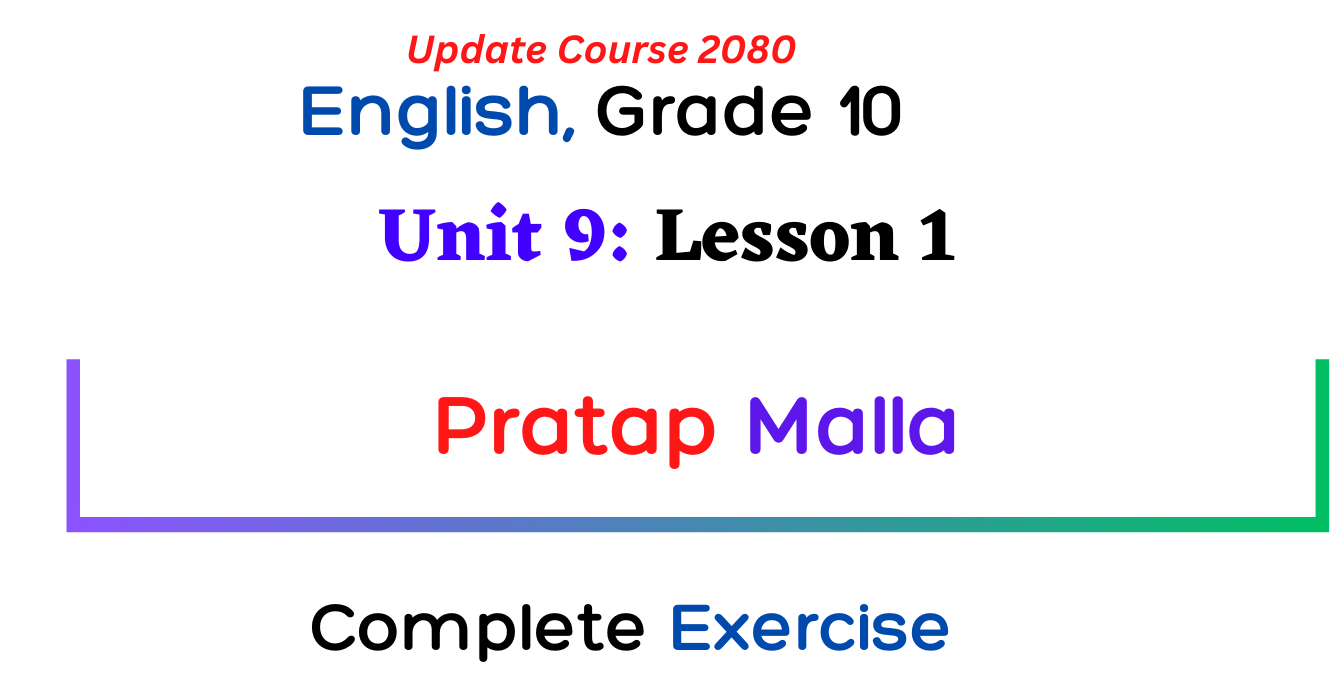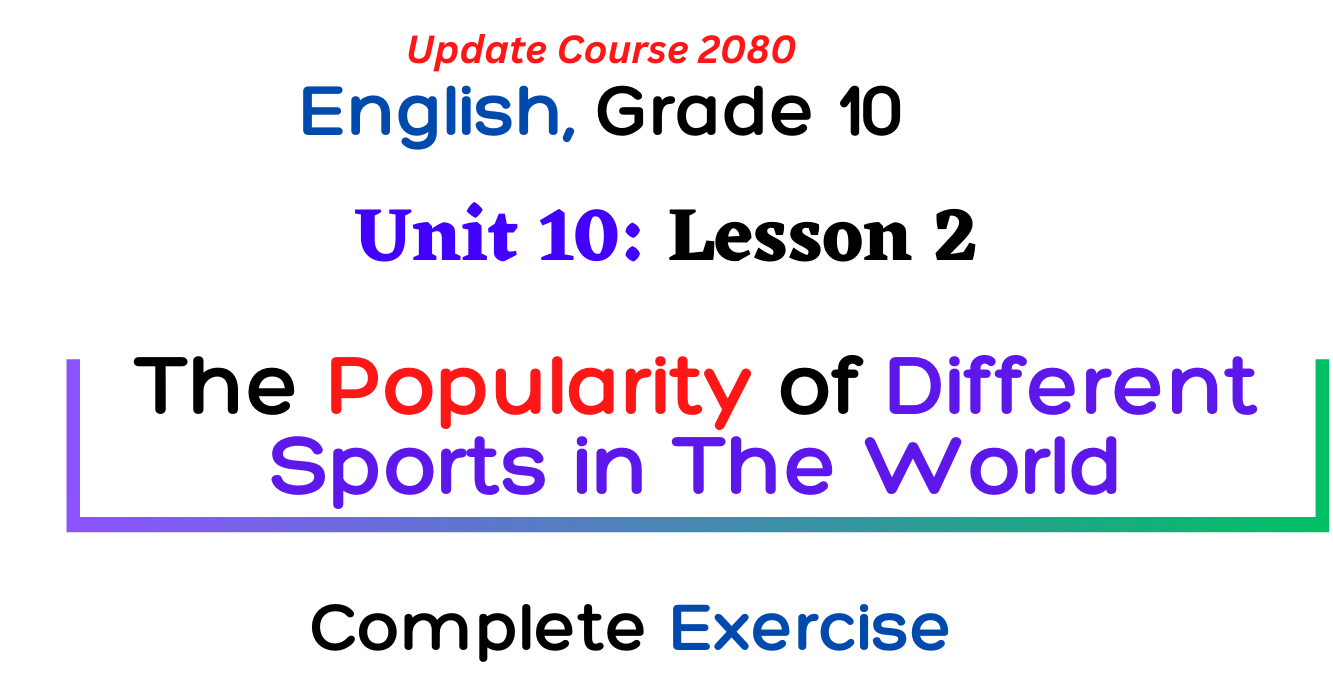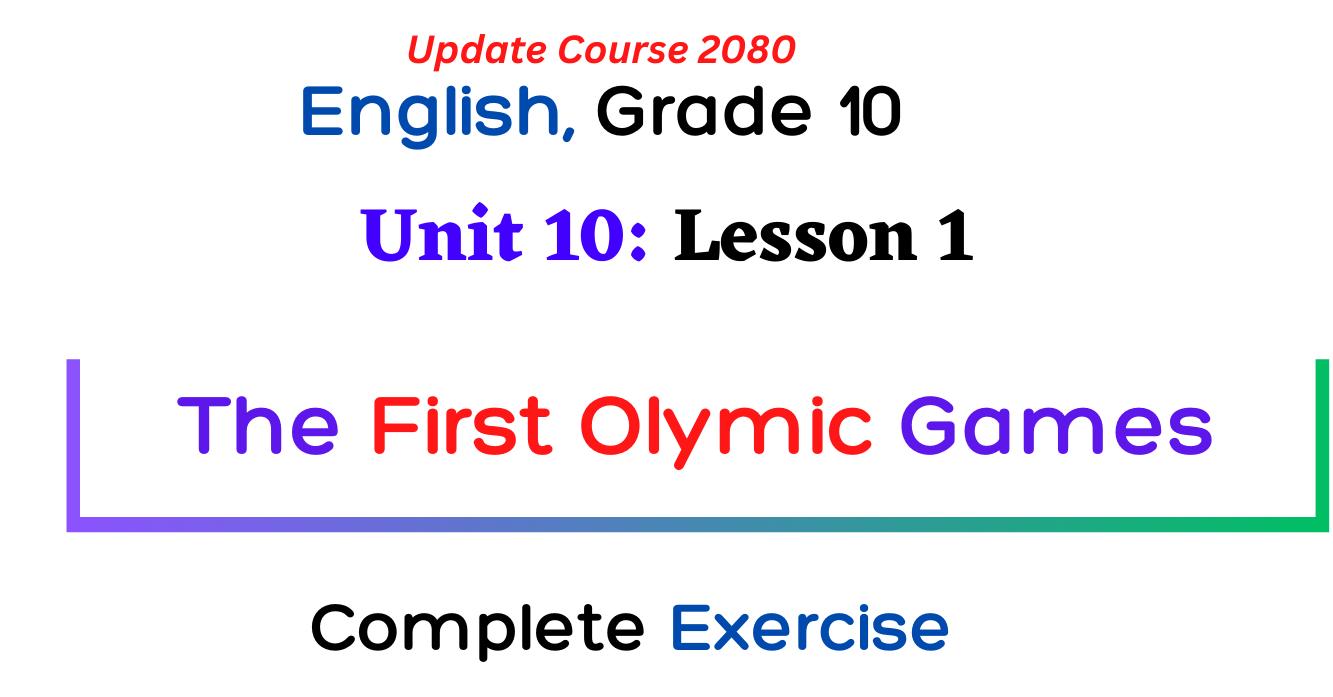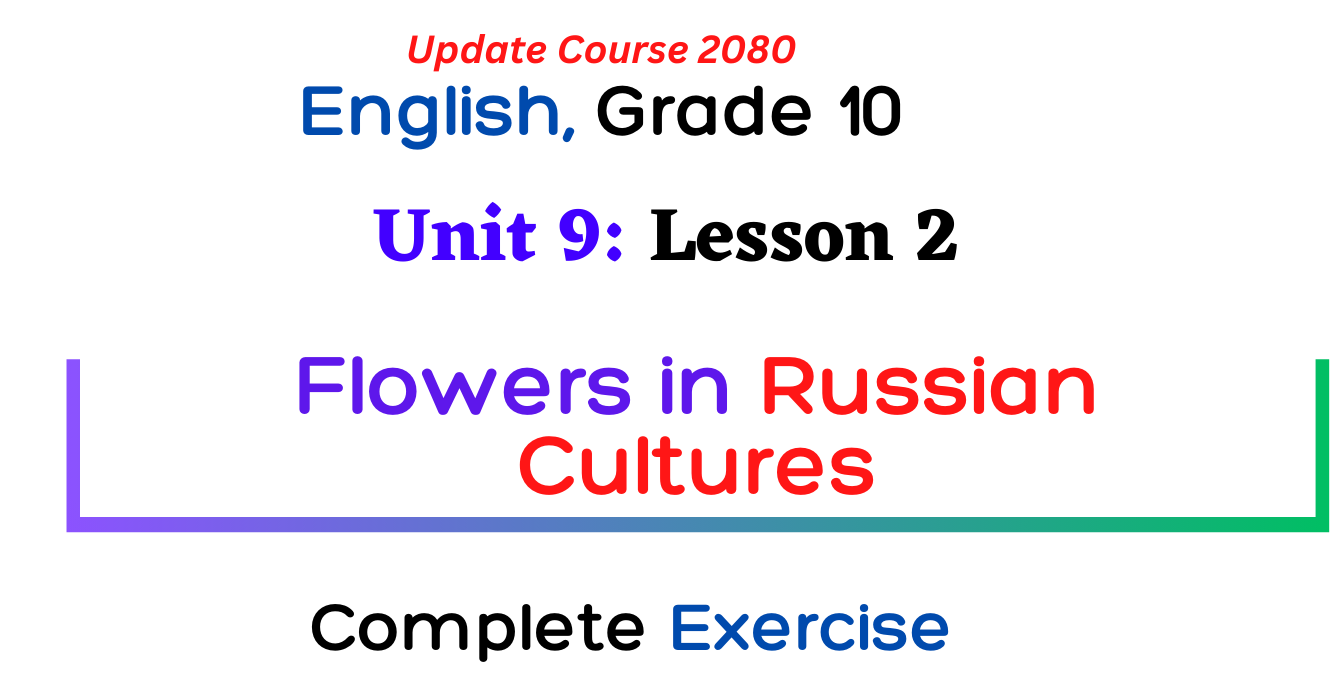Climbing
Class 10 English Guide 2080 Unit 9 History & Culture, Lesson 1 Pratap Malla Exercise, Question Answer, Summary Grammar Writing Solution note.
Check: SEE Class 10 Model Question 2080/2081
Reading I
A. Complete the following sentences with the correct words from the text.
Answer :
a. Queen Rajendra Laxmi ruled the country as a regent because her son Rana Bahadur Shah was too young.
b. Many buildings were renovated as they were destroyed by the earthquake..
c. Many temples had their pinnacles made of gold.
d. As the original trophy was stolen, they made the exact replica of it.
e. Madhav Prasad Ghimire was conferred the title ‘Rastrakavi’ in 2003.
f. The government patronised Jhamak Kumari Ghimire for her contribution to Nepali literature.
g. The British soldiers tried to invade Nepal but the brave Nepali people chased them away.
B. Choose the best alternative.
Answer :
a. Why did Pratap Malla keep his father in jail?
Ans: ii. Pratap Malla wanted to be the king soon.
b. What made Kantipur a strong state during Pratap Mallais reign?
Ans: ii. Pratap Malla’s diplomacy
c. Which of the following was not renovated by Pratap Malla?
Ans: iv. Temple of Budhanilkantha
d. One of the problems with driverless technology is that….
Ans: it can’t deal with human drivers.
e. According to the text, which of the following did not happen during Pratap Malla’s reign?
Ans:- iii. Invasion of Kantipur
C. Answer these questions.
Answer :
a. Name two countries that had trade with Kantipur.
Ans: Two countries that engaged in trade with Kantipur during Pratap Malla’s reign were India and China.
b. How did Pratap Malla keep his kingdom safe from Lalitpur and Bhaktapur?
Ans: Pratap Malla ensured the safety of his kingdom from Lalitpur and Bhaktapur by employing a strategic approach. He fostered a divide-and-conquer tactic, playing the kings of Lalitpur and Bhaktapur against each other. At times, he aligned with Bhaktapur to pose a threat to Lalitpur, while on other occasions, he allied with Lalitpur and confronted Bhaktapur.
c. Where did Pratap Malla place the image of Lord Hanuman? Why?
Ans: Pratap Malla placed the image of Lord Hanuman beside the gate of his palace, which he named Hanuman dhoka. He did this to ward off negative influences and protect his kingdom from evil forces.
d. Pratap Malla conferred himself with the title ‘Kabeendral. Do you think this title suit him? Give reasons.
Ans: Pratap Malla bestowed upon himself the title of ‘Kabeendral,’ meaning the king of poets. This title suits him well due to his extensive knowledge and poetic abilities. He possessed the talent to compose poems in multiple languages, including Sanskrit, Nepal Bhasa, Nepali, Bengali, and Hindi.
e. Pratap Malla used to invite the intellectuals at his palace. What does this indicate about his personality as a king?
Ans: By inviting intellectuals to his palace, Pratap Malla demonstrated his personality as a king who valued and supported scholars. This reflects his interest in learning, as well as his dedication to promoting and nurturing the arts and literature of his time.
D. Pratap Malla contributed a lot to Nepali culture during his reign. Can you name some of them which still exist?
Answer :
Pratap Malla, also known as Pratap Singh Malla, was a significant figure in Nepali history and his reign from 1641 to 1674 made lasting contributions to Nepali culture. Some of his contributions that still exist today include:
Architecture: Pratap Malla was a patron of art and architecture, and he commissioned the construction of numerous temples, palaces, and public squares. One of his most renowned architectural contributions is the Kathmandu Durbar Square, which houses several temples and palaces that reflect the rich cultural heritage of Nepal.
Temples and Shrines: Pratap Malla’s reign saw the construction of many temples and shrines in Kathmandu Valley. Some notable examples include the Krishna Mandir, Jagannath Mandir, and the Taleju Temple in Kathmandu Durbar Square. These sacred structures are still actively worshipped and hold religious significance for the Nepali people.
Festivals: Pratap Malla played a pivotal role in promoting and preserving Nepali festivals. He instituted various cultural events and religious festivals, including the famous Indra Jatra, which is celebrated annually in Kathmandu Valley. Indra Jatra is a vibrant festival featuring masked dances, processions, and religious ceremonies.
Art and Literature: Pratap Malla’s reign witnessed a flourishing of art and literature. He encouraged and supported poets, writers, and artists, leading to the creation of numerous literary and artistic works. The court of Pratap Malla became a hub for poets and scholars, fostering creativity and cultural exchange.
Royal Traditions: Pratap Malla established and solidified several royal traditions that continue to shape Nepali culture today. He introduced royal rituals, customs, and ceremonies that became an integral part of Nepali monarchial heritage.
These are just a few examples of Pratap Malla’s contributions to Nepali culture during his reign. His patronage of the arts, promotion of religious festivals, architectural endeavors, and support for literature left a lasting impact on the cultural fabric of Nepal.
Grammar I
A. Find the second part of each sentence. Then, change each verb into the correct form.
Answer :
a. The alarm (go)
Ans: ii. while Trishna (sleep).
b. As soon as the teacher (ask) the question
Ans: i. Brinda (reply) her.
c. I (do) my homework
Ans: iv. when the telephone (ring).
d. When the doors (open)
Ans: v. the audience (rush) into the stadium.
e. When we (wake)
Ans: ili. we (see) the sun shining brightly.
B. Complete the sentences. Write in the correct form of each verb.
Answer :
a. When I arrived home, my dad was preparing snacks for me.
b. That day, when we left home, the sky was overcast and it was drizzling .
c. Last week, we booked a hotel online. The hotel was really wonderful. The staff were standing at the gate to welcome us when we reached there.
d. Were the children sleeping when you reached home that night?
e. Something very strange happened on my way home yesterday. I was walking along the way. Suddenly, I saw my grandfather following But he had died a year ago.
f. We were traveling to Chitwan when the police stopped us on the way. According to them, there was a bomb there. So, we had to wait for an hour.
C. Make sentences using the words given in the brackets. Use the correct forms of the verbs: simple past or past continuous.
Answer :
a. It began to snow while we were returning home.
b. Kamal fell off while he was playing on the verandah.
c. Amit was waiting for me when I reached the station.
d. Simran took my photos while I was not looking at the camera.
e. What were you doing yesterday when I called you?
f. I broke the glass while I was washing it.
g. The teacher entered the class while some students were dancing in the class.
h. I found the lost purse while I was cleaning the room.
i. Dipisha finished her homework while her brother was watching TV.
Writing I
A. Study the events below. These are the major events that happened in the history of Nepal from 2017 B.S. to 2046 B.S. Write a couple of paragraphs about Nepal’s journey from Panchayat to Multiparty Democracy.
Answer :
Nepal’s transition from the Panchayat System to a multiparty democracy was a lengthy and tumultuous process. It all began on January 1, 2017, when King Mahendra dismissed the elected government, suspended parliament, imprisoned the Prime Minister and Ministers, banned political parties and activities, and consolidated his power. This led to the establishment of the autocratic Panchayat System on January 22, 2017, which lasted for almost thirty years. While this period provided some stability, it was marred by corruption, human rights abuses, and the suppression of dissent.
In 2036, King Birendra announced a referendum to determine whether the Panchayat System should continue or if a multiparty democracy should be established. The election took place on April 20, 2037, with the majority of people voting in favor of a multiparty democracy. However, the King disregarded the result, and Nepal remained under the Panchayat System for another five years.
In 2042, a non-violent civil disobedience movement was launched against the Panchayat System. This movement was led by various political parties, civil society organizations, and student groups. Initially suppressed, the movement gained momentum and forced the government to make some concessions. Eventually, on February 7, 2046, the mass movement officially commenced and continued for several weeks until the King agreed to restore the multiparty system on April 26, 2046.
The restoration of multiparty democracy marked a significant turning point in Nepal’s history. It brought forth political freedom, respect for human rights, and economic growth. The journey from the Panchayat System to multiparty democracy in Nepal was arduous and demanding, but it demonstrated the resilience and determination of the Nepali people to achieve their aspirations for a brighter future.
B. Some people think studying history is just a waste of time while others think that it is essential. What do you think of these ideas? Write your opinion in about 200 words.
Answer:
In my opinion, studying history is not just a waste of time; it is essential for several reasons. History provides us with a deeper understanding of the world we live in today. It allows us to examine the past, learn from it, and make informed decisions for the future.
Firstly, history helps us comprehend the present by shedding light on the origins of social, political, and cultural systems. By studying the past, we can identify patterns, trends, and factors that have shaped our societies and institutions. This knowledge enables us to navigate current challenges more effectively, as we can draw upon the lessons of the past.
Secondly, history promotes critical thinking and analysis. It teaches us to evaluate sources, analyze evidence, and develop coherent arguments. These skills are invaluable in various fields, including law, journalism, and policymaking. History also fosters empathy and tolerance by exposing us to diverse perspectives and cultures. By understanding the experiences of others in different times and places, we become more empathetic and open-minded individuals.
Furthermore, studying history helps us avoid repeating past mistakes. By examining the consequences of past actions and decisions, we can make more informed choices in the present. History serves as a cautionary tale, reminding us of the dangers of prejudice, extremism, and authoritarianism.
Lastly, history allows us to appreciate human achievements and understand our collective heritage. It helps us preserve cultural identities, traditions, and shared values. By studying the accomplishments of past civilizations, we gain a sense of continuity and a connection to those who came before us.
In conclusion, studying history is far from being a waste of time; it is an essential discipline that enriches our understanding of the world, enhances critical thinking skills, fosters empathy, and guides us towards a better future.
Next Chapter: Unit 9 Lesson 2:Flowers In Russian Culture
Read More
Class 10 English Notes – All Chapters 2080
Unit 10 Lesson 1: The First Olympic Game
Unit 10 Lesson 2: The Popularity of Different Sports in The World




